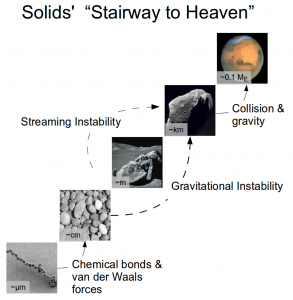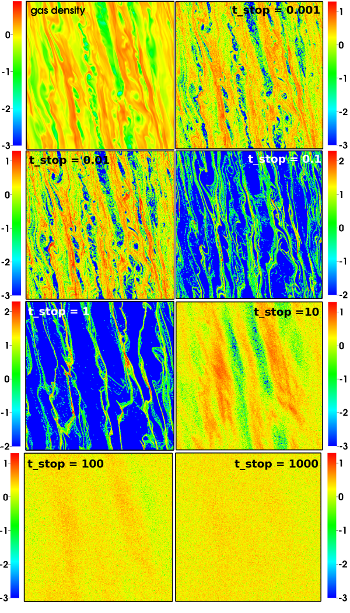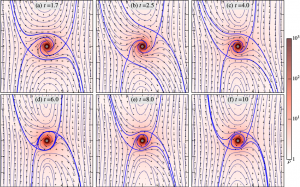Planet Formation
 Understanding how planets form is a key challenge in astrophysics. It has to answer how the solids grow over 40 orders of magnitude in mass, from μm ISM grains to 104 km giant planets. Solids grow by sticking at the smallest sizes. Gravity promotes the growth of km-sized objects, the so-called planetesimals, via pairwise collision. The growth of intermediate sizes solids (cm – km) however presents the most challenging of terrain due to its lack of viable physical mechanisms. Self-gravity is an attractive means. For ensembles of dust particles to aggregate into self-gravitating, bound structures, they must first collect into regions of extraordinarily high density in circumstellar gas disks. One question to ask therefore is how dense is necessary to trigger the instability and form bound solid objects? To answer
Understanding how planets form is a key challenge in astrophysics. It has to answer how the solids grow over 40 orders of magnitude in mass, from μm ISM grains to 104 km giant planets. Solids grow by sticking at the smallest sizes. Gravity promotes the growth of km-sized objects, the so-called planetesimals, via pairwise collision. The growth of intermediate sizes solids (cm – km) however presents the most challenging of terrain due to its lack of viable physical mechanisms. Self-gravity is an attractive means. For ensembles of dust particles to aggregate into self-gravitating, bound structures, they must first collect into regions of extraordinarily high density in circumstellar gas disks. One question to ask therefore is how dense is necessary to trigger the instability and form bound solid objects? To answer
this, I modified the ATHENA code to simulate dusty, compressible, self-gravitating flows in a 3D shearing box configuration, working in the limit that dust particles are small enough to be perfectly entrained in gas.
We find the density requirement is extremely high to form planetesimals from small particles via direct gravitational collapse (see the movie for an example of collapse with high enough density) due to the stabilized effects of gas pressure. (paper on ADS & astro-ph).
 However, the dynamics of solid bodies in protoplanetary discs are also subject to the properties of any underlying gas turbulence. Turbulence driven by disc self-gravity shows features distinct from those driven by the magnetorotational instability (MRI). I therefore study the dynamics of solids in gravito-turbulent discs with two-dimensional (in the disc plane), hybrid (particle and gas) simulations. Gravito-turbulent discs can exhibit stronger gravitational stirring than MRI-active discs, resulting in greater radial diffusion and larger eccentricities and relative speeds for large particles (those with dimensionless stopping times tstopΩ > 1, where Ω is the orbital frequency). The agglomeration of large particles into planetesimals by pairwise collisions is therefore disfavoured in gravito-turbulent discs. However, the relative speeds of intermediate-size particles (tstop Ω∼1) are significantly reduced as such particles are collected by gas drag and gas gravity into coherent filament-like structures with densities high enough to trigger gravitational collapse. First-generation planetesimals may form via gravitational instability of dust in marginally gravitationally unstable gas discs.
However, the dynamics of solid bodies in protoplanetary discs are also subject to the properties of any underlying gas turbulence. Turbulence driven by disc self-gravity shows features distinct from those driven by the magnetorotational instability (MRI). I therefore study the dynamics of solids in gravito-turbulent discs with two-dimensional (in the disc plane), hybrid (particle and gas) simulations. Gravito-turbulent discs can exhibit stronger gravitational stirring than MRI-active discs, resulting in greater radial diffusion and larger eccentricities and relative speeds for large particles (those with dimensionless stopping times tstopΩ > 1, where Ω is the orbital frequency). The agglomeration of large particles into planetesimals by pairwise collisions is therefore disfavoured in gravito-turbulent discs. However, the relative speeds of intermediate-size particles (tstop Ω∼1) are significantly reduced as such particles are collected by gas drag and gas gravity into coherent filament-like structures with densities high enough to trigger gravitational collapse. First-generation planetesimals may form via gravitational instability of dust in marginally gravitationally unstable gas discs.
 Planets embedded in the disk would trap some amount of gas which might explains the origin of atmosphere found in some of the terrestrial exoplanets with big fraction of volatiles. In a series of paper, we first study with 2D hydro simulations. Our results (see our paper on ADS & astro-ph) show well bound steady atmosphere even for low mass planets which are one order of magnitude smaller than Earth-mass around 1 AU. And the size of the atmosphere grows with increasing planet mass. However, our study using more realistic 3D simulations (see our paper on ADS & astro-ph) discover unbound and dynamical atmosphere for these low mass planets (see the right figure which shows time sequence of streamlines and density). The atmosphere continuously exchanges gas with the surrounding circumstellar disk in a way much faster than its cooling time scale. It therefore offers possible explanations for the preponderance of super-Earths and mini-Neptunes – systems that are presumably gas-rich but rock-dominant.
Planets embedded in the disk would trap some amount of gas which might explains the origin of atmosphere found in some of the terrestrial exoplanets with big fraction of volatiles. In a series of paper, we first study with 2D hydro simulations. Our results (see our paper on ADS & astro-ph) show well bound steady atmosphere even for low mass planets which are one order of magnitude smaller than Earth-mass around 1 AU. And the size of the atmosphere grows with increasing planet mass. However, our study using more realistic 3D simulations (see our paper on ADS & astro-ph) discover unbound and dynamical atmosphere for these low mass planets (see the right figure which shows time sequence of streamlines and density). The atmosphere continuously exchanges gas with the surrounding circumstellar disk in a way much faster than its cooling time scale. It therefore offers possible explanations for the preponderance of super-Earths and mini-Neptunes – systems that are presumably gas-rich but rock-dominant.